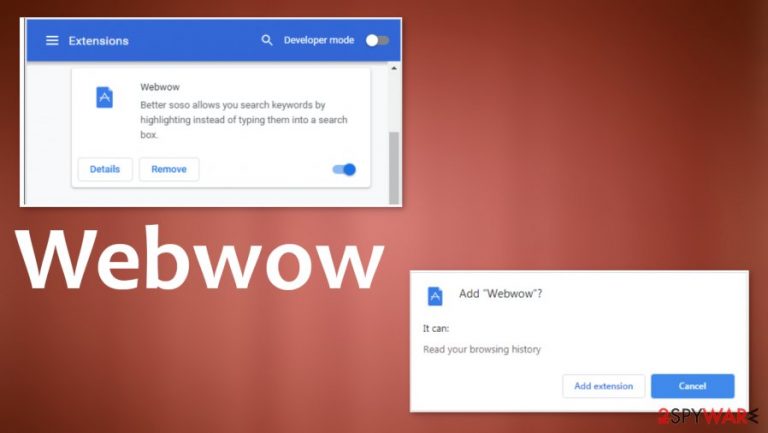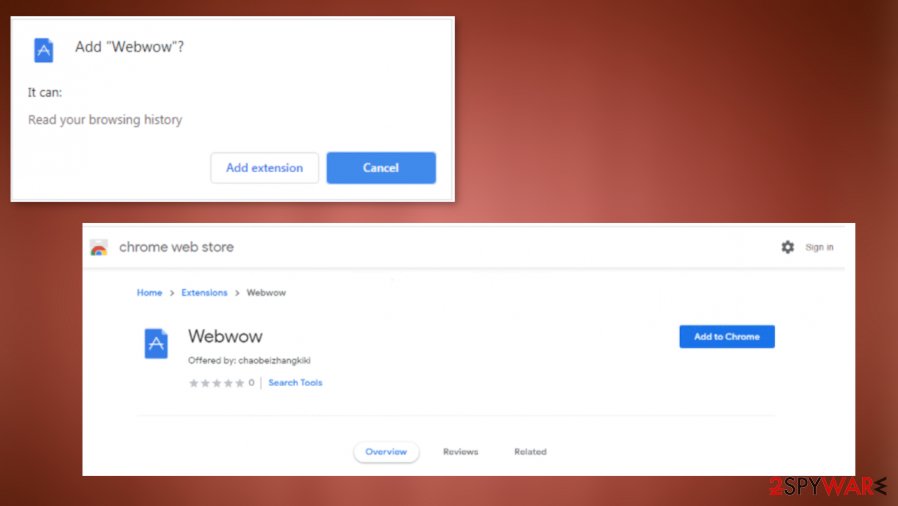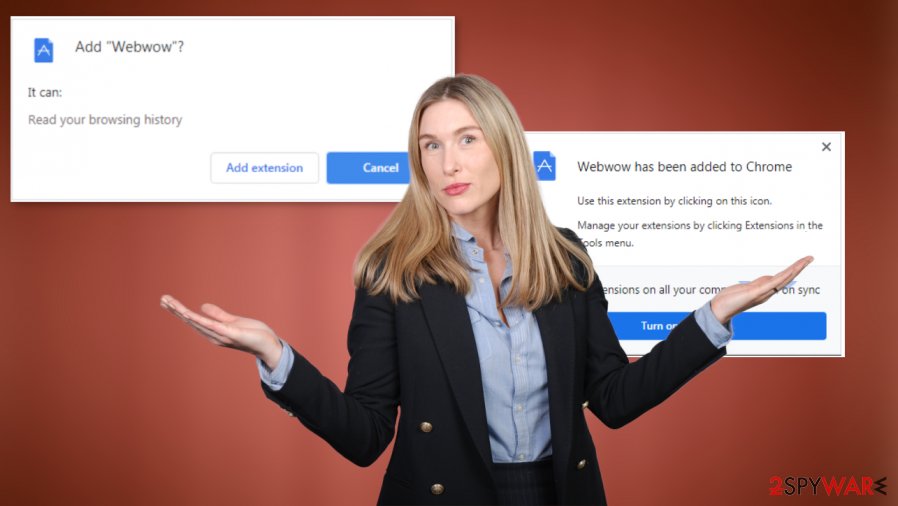Webwow (Virus Removal Instructions) - Removal Instructions
Webwow Removal Guide
What is Webwow?
Webwow – a browser hijacker that could pose a threat to privacy instead of providing it

Webwow is a PUP that is advertised to provide more security and privacy to internet users, but instead, such software is capable of collecting both browsing and private data, such as IP addresses, geolocation, search queries, visited sites, and so on. It is considered potentially unwanted or even dangerous because of these activities.
The program is categorized as a browser hijacker due to the fact that it changes various browser settings, such as the start page, new tab preference, the default search engine, etc. All this is done to promote a particular search engine by increasing its popularity and/or show advertisements from affiliated third-parties as the first search results.
Due to the risks of using Webwow virus as the main search engine browser hijacker, the way that it operates, and its spreading methods, this browser extension is deemed as a potentially unwanted program[1] (PUP).
| name | Webwow |
|---|---|
| type | Browser hijacker, potentially unwanted program, deceptive ads |
| Distribution | Software bundles, official browser web stores |
| Symptoms | If Webwow extension is installed on your device, these alterations are made – changed default search provider, changed new tab and home page preferences |
| Risks | Browser hijackers are capable of gathering various browsing and personal data which might be sold to third-parties to present individually tailored ads or worse – to cybercriminals with ill intensions |
| Virus removal | We provide free detailed instructions at the bottom of this article on how to uninstall this browser hijacker from all devices |
| System fix | To restore any changes that the PUP might have done to system files and settings, use system repair tools like the FortectIntego or similar |
Like the Webwow browser intruder, potentially unwanted programs are spread using deceptive techniques. Usually, they end up on everyday computer users' devices without their direct consent or by tricking them into installing them. The most common distribution methods are:
- Deceptive advertisements;
- Software bundles;
- Fake updates;
- Browser official web stores.
As we've mentioned before, browser hijackers have the ability to gather various browsing and private data. This collected information might be shared or sold to third parties to bombard users with personally tailored ads. Some interested parties could have worse ideas on how to use the data, e.g., cyberattacks that could lead to privacy risks, including identity theft.
Browser hijackers could not only change various browser settings but also redirect users to affiliated third-party websites with malicious content, where users might get tricked into installing more PUPs or even some malware. So we recommend users to remove Webwow browser extension for their own safety.

At the bottom of this article, we're giving our readers a free guide on how to uninstall the PUP from their devices. Although to make sure that Webwow removal was successful and that no additional PUPs or malware were installed, we recommend performing a full system scan with dependable anti-malware tools such as SpyHunter 5Combo Cleaner or Malwarebytes.
Afterward, system tune-up should be done for users' peace of mind. Browser hijackers might alter various system settings resulting in unstable performance, crashing, severe lag, and other system irregularities. That's why experts[2] recommend using the FortectIntego tool for system repair.
Stay away from software bundles to avoid PUPs
Potentially unwanted programs, including adware and browser hijackers, can be installed on unaware user devices (computers and cell phones) in various ways, as we've mentioned before. But our research shows that the most prevalent distribution technique is software (or freeware) bundles.[3]

When such bundles are downloaded, users rarely take the time to read the Terms & Conditions or to choose the Advanced/Custom installation mode. And that's where they get tricked. All boxes opting in for the installation of all software within the bundle are pre-selected. So as soon as the user agrees with Quick or Standard installation, every app gets installed.
It's very easy to avoid PUPs. Either avoid software bundles altogether or the next time when installing software from it, choose the Advanced or Custom mode and deselect all the pre-ticked boxes for the applications that you don't want or that you didn't even know would be installed on your device.
Webwow virus removal instructions and tips for system improvements
As we've pointed out in the first chapter of this article, it's unsafe to keep using this search application. So whether you installed it willingly or the browser hijacker got into your device unknowingly, we recommend all users remove Webwow browser extension.
All users can do it effortlessly with our free guide provided at the bottom of this article, as no experience is needed for that. But to make sure that malware or additional PUPs weren't installed, we still recommend performing a full system scan with trustworthy anti-malware software.
Once the users are done with Webwow removal, we suggest taking care of their devices' overall health. The best way to do it is by using a system repair tool that would restore system registry values and fix any other issues that the browser hijacker could have caused.
You may remove virus damage with a help of FortectIntego. SpyHunter 5Combo Cleaner and Malwarebytes are recommended to detect potentially unwanted programs and viruses with all their files and registry entries that are related to them.
Getting rid of Webwow. Follow these steps
Uninstall from Windows
Run through the system and try to find Webwow, so it can be removed
Instructions for Windows 10/8 machines:
- Enter Control Panel into Windows search box and hit Enter or click on the search result.
- Under Programs, select Uninstall a program.

- From the list, find the entry of the suspicious program.
- Right-click on the application and select Uninstall.
- If User Account Control shows up, click Yes.
- Wait till uninstallation process is complete and click OK.

If you are Windows 7/XP user, proceed with the following instructions:
- Click on Windows Start > Control Panel located on the right pane (if you are Windows XP user, click on Add/Remove Programs).
- In Control Panel, select Programs > Uninstall a program.

- Pick the unwanted application by clicking on it once.
- At the top, click Uninstall/Change.
- In the confirmation prompt, pick Yes.
- Click OK once the removal process is finished.
Delete from macOS
Remove items from Applications folder:
- From the menu bar, select Go > Applications.
- In the Applications folder, look for all related entries.
- Click on the app and drag it to Trash (or right-click and pick Move to Trash)

To fully remove an unwanted app, you need to access Application Support, LaunchAgents, and LaunchDaemons folders and delete relevant files:
- Select Go > Go to Folder.
- Enter /Library/Application Support and click Go or press Enter.
- In the Application Support folder, look for any dubious entries and then delete them.
- Now enter /Library/LaunchAgents and /Library/LaunchDaemons folders the same way and terminate all the related .plist files.

Remove from Microsoft Edge
Delete unwanted extensions from MS Edge:
- Select Menu (three horizontal dots at the top-right of the browser window) and pick Extensions.
- From the list, pick the extension and click on the Gear icon.
- Click on Uninstall at the bottom.

Clear cookies and other browser data:
- Click on the Menu (three horizontal dots at the top-right of the browser window) and select Privacy & security.
- Under Clear browsing data, pick Choose what to clear.
- Select everything (apart from passwords, although you might want to include Media licenses as well, if applicable) and click on Clear.

Restore new tab and homepage settings:
- Click the menu icon and choose Settings.
- Then find On startup section.
- Click Disable if you found any suspicious domain.
Reset MS Edge if the above steps did not work:
- Press on Ctrl + Shift + Esc to open Task Manager.
- Click on More details arrow at the bottom of the window.
- Select Details tab.
- Now scroll down and locate every entry with Microsoft Edge name in it. Right-click on each of them and select End Task to stop MS Edge from running.

If this solution failed to help you, you need to use an advanced Edge reset method. Note that you need to backup your data before proceeding.
- Find the following folder on your computer: C:\\Users\\%username%\\AppData\\Local\\Packages\\Microsoft.MicrosoftEdge_8wekyb3d8bbwe.
- Press Ctrl + A on your keyboard to select all folders.
- Right-click on them and pick Delete

- Now right-click on the Start button and pick Windows PowerShell (Admin).
- When the new window opens, copy and paste the following command, and then press Enter:
Get-AppXPackage -AllUsers -Name Microsoft.MicrosoftEdge | Foreach {Add-AppxPackage -DisableDevelopmentMode -Register “$($_.InstallLocation)\\AppXManifest.xml” -Verbose

Instructions for Chromium-based Edge
Delete extensions from MS Edge (Chromium):
- Open Edge and click select Settings > Extensions.
- Delete unwanted extensions by clicking Remove.

Clear cache and site data:
- Click on Menu and go to Settings.
- Select Privacy, search and services.
- Under Clear browsing data, pick Choose what to clear.
- Under Time range, pick All time.
- Select Clear now.

Reset Chromium-based MS Edge:
- Click on Menu and select Settings.
- On the left side, pick Reset settings.
- Select Restore settings to their default values.
- Confirm with Reset.

Remove from Mozilla Firefox (FF)
Remove dangerous extensions:
- Open Mozilla Firefox browser and click on the Menu (three horizontal lines at the top-right of the window).
- Select Add-ons.
- In here, select unwanted plugin and click Remove.

Reset the homepage:
- Click three horizontal lines at the top right corner to open the menu.
- Choose Options.
- Under Home options, enter your preferred site that will open every time you newly open the Mozilla Firefox.
Clear cookies and site data:
- Click Menu and pick Settings.
- Go to Privacy & Security section.
- Scroll down to locate Cookies and Site Data.
- Click on Clear Data…
- Select Cookies and Site Data, as well as Cached Web Content and press Clear.

Reset Mozilla Firefox
If clearing the browser as explained above did not help, reset Mozilla Firefox:
- Open Mozilla Firefox browser and click the Menu.
- Go to Help and then choose Troubleshooting Information.

- Under Give Firefox a tune up section, click on Refresh Firefox…
- Once the pop-up shows up, confirm the action by pressing on Refresh Firefox.

Remove from Google Chrome
You might also find some shady applications installed on the machine, so make sure to remove them manually or run full resetting
Delete malicious extensions from Google Chrome:
- Open Google Chrome, click on the Menu (three vertical dots at the top-right corner) and select More tools > Extensions.
- In the newly opened window, you will see all the installed extensions. Uninstall all the suspicious plugins that might be related to the unwanted program by clicking Remove.

Clear cache and web data from Chrome:
- Click on Menu and pick Settings.
- Under Privacy and security, select Clear browsing data.
- Select Browsing history, Cookies and other site data, as well as Cached images and files.
- Click Clear data.

Change your homepage:
- Click menu and choose Settings.
- Look for a suspicious site in the On startup section.
- Click on Open a specific or set of pages and click on three dots to find the Remove option.
Reset Google Chrome:
If the previous methods did not help you, reset Google Chrome to eliminate all the unwanted components:
- Click on Menu and select Settings.
- In the Settings, scroll down and click Advanced.
- Scroll down and locate Reset and clean up section.
- Now click Restore settings to their original defaults.
- Confirm with Reset settings.

Delete from Safari
Remove unwanted extensions from Safari:
- Click Safari > Preferences…
- In the new window, pick Extensions.
- Select the unwanted extension and select Uninstall.

Clear cookies and other website data from Safari:
- Click Safari > Clear History…
- From the drop-down menu under Clear, pick all history.
- Confirm with Clear History.

Reset Safari if the above-mentioned steps did not help you:
- Click Safari > Preferences…
- Go to Advanced tab.
- Tick the Show Develop menu in menu bar.
- From the menu bar, click Develop, and then select Empty Caches.

After uninstalling this potentially unwanted program (PUP) and fixing each of your web browsers, we recommend you to scan your PC system with a reputable anti-spyware. This will help you to get rid of Webwow registry traces and will also identify related parasites or possible malware infections on your computer. For that you can use our top-rated malware remover: FortectIntego, SpyHunter 5Combo Cleaner or Malwarebytes.
How to prevent from getting browser hijacker
Choose a proper web browser and improve your safety with a VPN tool
Online spying has got momentum in recent years and people are getting more and more interested in how to protect their privacy online. One of the basic means to add a layer of security – choose the most private and secure web browser. Although web browsers can't grant full privacy protection and security, some of them are much better at sandboxing, HTTPS upgrading, active content blocking, tracking blocking, phishing protection, and similar privacy-oriented features. However, if you want true anonymity, we suggest you employ a powerful Private Internet Access VPN – it can encrypt all the traffic that comes and goes out of your computer, preventing tracking completely.
Lost your files? Use data recovery software
While some files located on any computer are replaceable or useless, others can be extremely valuable. Family photos, work documents, school projects – these are types of files that we don't want to lose. Unfortunately, there are many ways how unexpected data loss can occur: power cuts, Blue Screen of Death errors, hardware failures, crypto-malware attack, or even accidental deletion.
To ensure that all the files remain intact, you should prepare regular data backups. You can choose cloud-based or physical copies you could restore from later in case of a disaster. If your backups were lost as well or you never bothered to prepare any, Data Recovery Pro can be your only hope to retrieve your invaluable files.
- ^ Chris Hoffman. PUPs Explained: What is a “Potentially Unwanted Program”?. Howtogeek. We explain technology.
- ^ Zondervirus. Zondervirus. Spyware news and security.
- ^ Product bundling. Wikipedia. The free encyclopedia.
